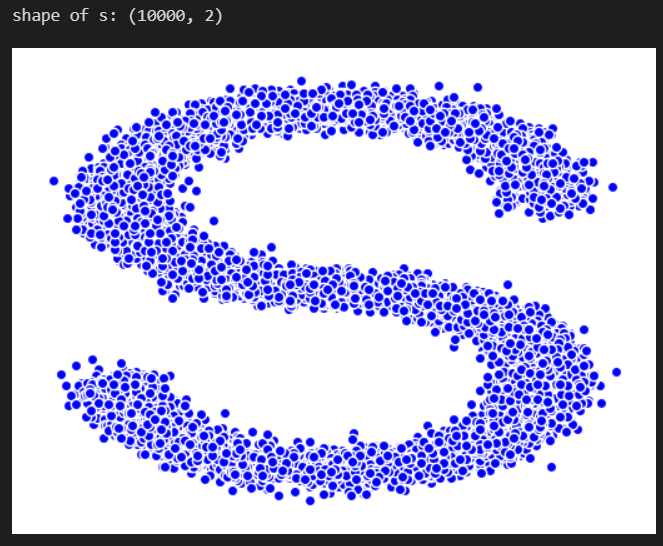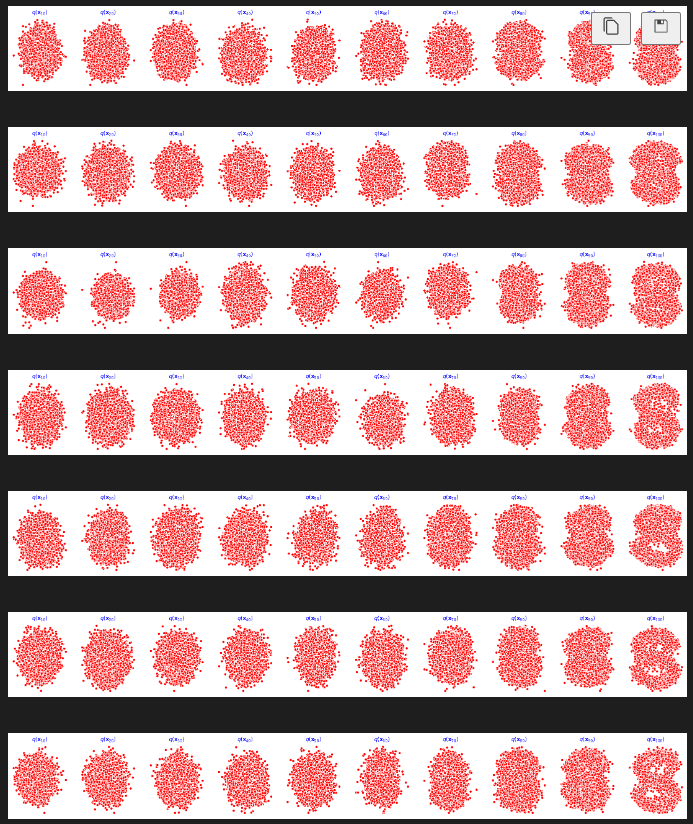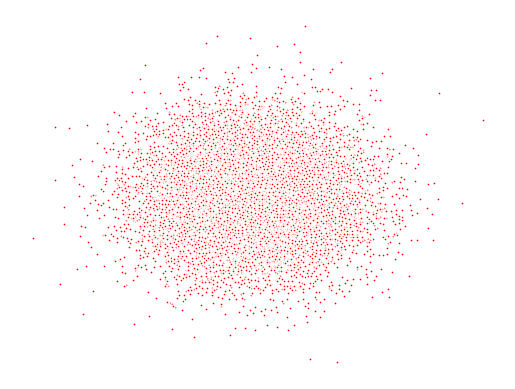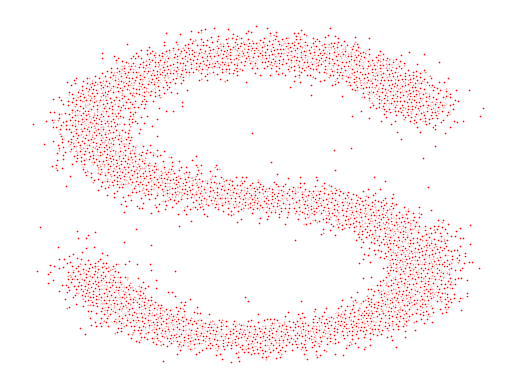扩散模型example
%matplotlib inline
import matplotlib.pyplot as plt
import numpy as np
from sklearn.datasets import make_s_curve
import torch
1. 生成数据
s_curve,_ = make_s_curve(10**4,noise=0.1)# 1万个点
print(_.shape)
print(s_curve[0])#点的三维坐标,(x,y,z)
# print(s_curve[0].T)
# https://scikit-learn.org/stable/auto_examples/manifold/plot_compare_methods.html#sphx-glr-auto-examples-manifold-plot-compare-methods-py
# https://blog.csdn.net/weixin_42887138/article/details/117656280
print(_[0]) # 点的颜色值
# 画出数据集的形状
s_curve,_ = make_s_curve(10**4,noise=0.1)# 产生1万个样本点,3维的(x,y,z)
s_curve = s_curve[:,[0,2]]/10.0 #取出(x,z)然后画出2维的S图
print("shape of s:",np.shape(s_curve))
data = s_curve.T
# data=s_curve
fig,ax = plt.subplots() # https://blog.csdn.net/htuhxf/article/details/82986440
ax.scatter(*data,color='blue',edgecolor='white');
ax.axis('off')
dataset = torch.Tensor(s_curve).float()
# 张量也可以写成dataset的,dataset不一定要写为class,当数据比较简单的时候,我们可以直接写成张量的形式

2. 确定超参数的值
num_steps = 100 # 即T,对于步骤,一开始可以由beta, 分布的均值和标准差来共同确定
#制定每一步的beta
betas = torch.linspace(-6,6,num_steps) # size:100
betas = torch.sigmoid(betas)*(0.5e-2 - 1e-5)+1e-5
# beta是递增的,最小值为0.00001,最大值为0.005, sigmooid func
# 像学习率一样的一个东西,而且是一个比较小的值,所以就有理由假设逆扩散过程也是一个高斯分布
#计算alpha、alpha_prod、alpha_prod_previous、alpha_bar_sqrt等变量的值
alphas = 1-betas # size: 100
alphas_prod = torch.cumprod(alphas,0) # size: 100
# 就是让每一个都错一下位
alphas_prod_p = torch.cat([torch.tensor([1]).float(),alphas_prod[:-1]],0) # p表示previous
# alphas_prod[:-1] 表示取出 从0开始到倒数第二个值
alphas_bar_sqrt = torch.sqrt(alphas_prod)
one_minus_alphas_bar_log = torch.log(1 - alphas_prod)
one_minus_alphas_bar_sqrt = torch.sqrt(1 - alphas_prod)
assert alphas.shape==alphas_prod.shape==alphas_prod_p.shape==\
alphas_bar_sqrt.shape==one_minus_alphas_bar_log.shape\
==one_minus_alphas_bar_sqrt.shape
print("all the same shape",betas.shape)
# 每一时刻这些量的值都是不一样的,但是他们是不需要训练的,是超参数
3. 确定扩散过程任意时刻的采样值
q
(
x
t
∣
x
0
)
=
N
(
x
t
;
α
ˉ
t
x
0
,
(
1
−
α
ˉ
t
)
I
)
q(x_{t}|x_{0})=N(x_{t};\sqrt{\bar\alpha_{t}}x_{0},(1-\bar\alpha_{t})I)
q(xt∣x0)=N(xt;αˉtx0,(1−αˉt)I)
即给定初始的
x
0
x_{0}
x0的分布就可以求出任意时刻
x
t
x_{t}
xt的采样值
μ
=
α
ˉ
t
x
0
,
σ
=
1
−
α
ˉ
t
\mu=\sqrt{\bar\alpha_{t}}x_{0},\sigma=\sqrt{1-\bar\alpha_{t}}
μ=αˉtx0,σ=1−αˉt
noise:
ϵ
\epsilon
ϵ
x
0
=
ϵ
∗
σ
+
μ
x_{0}=\epsilon*\sigma + \mu
x0=ϵ∗σ+μ
#计算任意时刻的x采样值,基于x_0和重参数化
def q_x(x_0,t):
"""可以基于x[0]得到任意时刻t的x[t]"""
noise = torch.randn_like(x_0) # noise是从正态分布中生成的随机噪声
alphas_t = alphas_bar_sqrt[t]
alphas_1_m_t = one_minus_alphas_bar_sqrt[t]
return (alphas_t * x_0 + alphas_1_m_t * noise)#在x[0]的基础上添加噪声
# 上面就可以通过x0和t来采样出xt的值
4. 演示原始数据分布加噪100步后的结果
num_shows = 20
fig,axs = plt.subplots(2,10,figsize=(28,5))
plt.rc('text',color='black')
#共有10000个点,每个点包含两个坐标
#生成100步以内每隔5步加噪声后的图像
for i in range(num_shows):
j = i//10
k = i%10
# 每一时刻的点都是基于q(xt|x0)采样得到的
q_i = q_x(dataset,torch.tensor([i*num_steps//num_shows]))#生成t时刻的采样数据, //表示地板除,先做除法,再向下取整
axs[j,k].scatter(q_i[:,0],q_i[:,1],color='red',edgecolor='white')
axs[j,k].set_axis_off()
axs[j,k].set_title('$q(\mathbf{x}_{'+str(i*num_steps//num_shows)+'})$')
# forward diffusion process 不含参数

5. 编写拟合逆扩散过程高斯分布的模型
对应于
L
s
i
m
p
l
e
(
θ
)
L_{simple(\theta)}
Lsimple(θ)中的
ϵ
θ
(
α
ˉ
t
x
0
+
1
−
α
ˉ
t
ϵ
,
t
)
\epsilon_{\theta}(\sqrt{\bar \alpha_{t}}x_{0}+\sqrt{1-\bar\alpha_{t}}\epsilon,t)
ϵθ(αˉtx0+1−αˉtϵ,t), 左式以
x
0
,
t
x_{0}, t
x0,t作为输入,输出是与
x
0
x_{0}
x0的形状一致的一个网络,因为
ϵ
θ
\epsilon_{\theta}
ϵθ就是要去逼近
ϵ
\epsilon
ϵ,而
ϵ
\epsilon
ϵ是与
x
0
x_{0}
x0的形状一致
下面MLPDiffusion中forward(self, x,t)中的x其实指的是
α
ˉ
t
x
0
+
1
−
α
ˉ
t
ϵ
\sqrt{\bar \alpha_{t}}x_{0}+\sqrt{1-\bar\alpha_{t}}\epsilon
αˉtx0+1−αˉtϵ
import torch
import torch.nn as nn
class MLPDiffusion(nn.Module):
def __init__(self,n_steps,num_units=128):
super(MLPDiffusion,self).__init__()
# https://blog.csdn.net/weixin_36670529/article/details/105910767
# 它和torch的其他机制结合紧密,继承了nn.Module的网络模型class可以使用nn.ModuleList并识别其中的parameters,当然这只是个list,不会自动实现forward方法。可见,
# 普通list中的子module并不能被主module所识别,而ModuleList中的子module能够被主module所识别
# nn.Sequential定义的网络中各层会按照定义的顺序进行级联,需要保证各层的输入和输出之间要衔接
# nn.Sequential实现了forward()方法,因此可以直接通过x = self.combine(x)的方式实现forward
# 而nn.ModuleList则没有顺序性要求,也没有forward()方法
self.linears = nn.ModuleList(
[
nn.Linear(2,num_units),
nn.ReLU(),
nn.Linear(num_units,num_units),
nn.ReLU(),
nn.Linear(num_units,num_units),
nn.ReLU(),
nn.Linear(num_units,2), # input shape = output shape = 2
]
)
# https://pytorch.org/docs/stable/generated/torch.nn.Embedding.html
self.step_embeddings = nn.ModuleList(
[
nn.Embedding(n_steps,num_units), # 一个字典中有100个词,每个词嵌入向量的大小为128 dim
nn.Embedding(n_steps,num_units),
nn.Embedding(n_steps,num_units), # n_step=T=100步,num_units即hidden layer的parameter
]
)
def forward(self,x,t):
# 训练的时候不是按顺序给的,是随机采样的,需要额外的时间信息
# 也可以不用embedding,直接送T进去训练,但这种信息无法很好学到,embedding层会嵌入时间的信息,变成网络更容易理解的模式。
# transformer也是这样加时间信息的
# x = x_0
for idx,embedding_layer in enumerate(self.step_embeddings):
t_embedding = embedding_layer(t) # 把t编码为128维的embedding
x = self.linears[2*idx](x) # linear
x += t_embedding # embedding是通过加法加进去的
x = self.linears[2*idx+1](x) # relu
x = self.linears[-1](x) # linear,保证x的形状不变
return x
6. 编写训练的误差函数
L s i m p l e ( θ ) : = E t , x 0 , ϵ [ ∣ ∣ ϵ − ϵ θ ( α ˉ t x 0 + 1 − α ˉ t ϵ , t ) ∣ ∣ 2 ] L_{simple}(\theta) := \mathbb{E}_{t,x_{0},\epsilon}\left[||\epsilon-\epsilon_{\theta}(\sqrt{\bar \alpha_{t}}x_{0}+\sqrt{1-\bar\alpha_{t}}\epsilon,t)||^{2}\right] Lsimple(θ):=Et,x0,ϵ[∣∣ϵ−ϵθ(αˉtx0+1−αˉtϵ,t)∣∣2]
model: 算出
ϵ
θ
\epsilon_{\theta}
ϵθ
n_steps:算loss时,从时间范围内随机生成一些t
model:输入的其实是
x
t
,
t
x_t, t
xt,t, 这个
x
t
x_t
xt是通过前向扩散过程
x
0
x_0
x0 和
ϵ
\epsilon
ϵ 计算出来的,即
x
t
=
α
ˉ
x
0
+
1
−
α
ˉ
t
ϵ
x_t=\sqrt{\bar{\alpha}}x_0+\sqrt{1-\bar\alpha_t}\epsilon
xt=αˉx0+1−αˉtϵ
,再输入到model中的, 得到
ϵ
θ
\epsilon_{\theta}
ϵθ
注意:
diffusion_loss_fn中的时间t 序列,并不是按顺序从
1
,
2
,
3
,
.
.
.
t
1,2,3,...t
1,2,3,...t,而是随机生成一系列的时刻t,因为
x
t
x_t
xt可以直接由
x
0
x_0
x0和t计算出来,所以其实在训练的过程中我们并不需要马尔科夫链的过程,一步就求出t时刻的
x
t
x_t
xt了。
def diffusion_loss_fn(model, x_0, alphas_bar_sqrt, one_minus_alphas_bar_sqrt, n_steps):
"""对任意时刻t进行采样计算loss"""
batch_size = x_0.shape[0]
# n_steps是为了算loss的时候,可以在n_steps这个范围内随机地生成一些t
#对一个batchsize样本生成随机的时刻t,覆盖到更多不同的t
t = torch.randint(0,n_steps,size=(batch_size//2,)) # size=(batch_size//2,)中的,不可少
t = torch.cat([t,n_steps-1-t],dim=0)# [batchsize]
t = t.unsqueeze(-1)#[batchsize, 1]
#x0的系数
a = alphas_bar_sqrt[t]
#eps的系数
aml = one_minus_alphas_bar_sqrt[t]
#生成随机噪音eps
e = torch.randn_like(x_0)
#构造模型的输入,即x_t可以用x_0和t来表示
x = x_0*a+e*aml
#送入模型,得到t时刻的随机噪声预测值
output = model(x,t.squeeze(-1))
#与真实噪声一起计算误差,求平均值
return (e - output).square().mean()
# 目的:让网络预测的噪声 接近于 真实扩散过程的噪声
7. 编写逆扩散采样函数(inference过程)
μ
θ
(
x
t
,
t
)
=
μ
t
∼
(
x
t
,
1
α
ˉ
t
(
x
t
−
1
−
α
ˉ
t
.
ϵ
θ
(
x
t
)
)
)
=
1
α
t
(
x
t
−
β
t
1
−
α
ˉ
t
.
ϵ
θ
(
x
t
,
t
)
)
\mu_{\theta}(\mathbf{x}_{t},t)=\overset{\sim}{\mu_{t}}\left(\mathbf{x}_{t},\frac{1}{\sqrt{\bar\alpha_{t}}}(\mathbf{x}_{t}-\sqrt{1-\bar\alpha_{t}}.\epsilon_{\theta}(\mathbf{x}_{t}))\right)=\frac{1}{\sqrt{\alpha_{t}}}\left(\mathbf{x}_{t}-\frac{\beta_{t}}{\sqrt{1-\bar\alpha_{t}}}.\epsilon_{\theta}(\mathbf{x}_{t},t)\right)
μθ(xt,t)=μt∼(xt,αˉt1(xt−1−αˉt.ϵθ(xt)))=αt1(xt−1−αˉtβt.ϵθ(xt,t))
里面的
ϵ
θ
\epsilon_{\theta}
ϵθ是通过模型算出来的,就是说这个模型的输出是
ϵ
θ
\epsilon_{\theta}
ϵθ
即下面函数p_sample中的mean
p
θ
(
x
t
−
1
∣
x
t
)
=
N
(
x
t
−
1
;
μ
θ
(
x
t
,
t
)
,
Σ
θ
(
x
t
,
t
)
)
p_{\theta}(\mathrm{x_{t-1}|x_{t}})=\mathcal{N}(\mathrm{x_{t-1};\mu_{\theta}(x_{t},t)},\Sigma_{\theta}(x_{t},t))
pθ(xt−1∣xt)=N(xt−1;μθ(xt,t),Σθ(xt,t)),在论文中将其方差
Σ
θ
(
x
t
,
t
)
\Sigma_{\theta}(x_{t},t)
Σθ(xt,t) 设置程一个与
β
\beta
β 相关的常数
σ
t
2
I
\sigma_{t}^{2}I
σt2I,且有
σ
t
2
=
β
t
∼
=
1
−
α
ˉ
t
−
1
1
−
α
ˉ
t
β
t
\sigma_{t}^{2}=\overset{\sim}{\beta_{t}}=\frac{1-\bar\alpha_{t-1}}{1-\bar\alpha_{t}}\beta_{t}
σt2=βt∼=1−αˉt1−αˉt−1βt
即
p
θ
(
x
t
−
1
∣
x
t
)
=
N
(
x
t
−
1
;
μ
θ
(
x
t
,
t
)
,
σ
t
2
I
)
p_{\theta}(x_{t-1}|x_{t})=\mathcal{N}(x_{t-1};\mu_{\theta}(x_{t},t),\sigma_{t}^{2}I)
pθ(xt−1∣xt)=N(xt−1;μθ(xt,t),σt2I)
−
−
−
−
−
−
−
−
−
−
----------
−−−−−−−−−−
但是下面的好像直接设置
σ
t
2
I
\sigma_{t}^{2}I
σt2I,且有
σ
t
2
=
β
t
\sigma_{t}^{2}=\beta_{t}
σt2=βt
上面方差的两种设置都可以,他们都不含参数
Algorithm 2 Sampling
x
T
∼
N
(
0
,
I
)
\mathbf{x}_{T}\sim N(0,I)
xT∼N(0,I)
x
t
−
1
=
1
α
t
(
x
t
−
1
−
α
t
1
−
α
ˉ
t
.
ϵ
θ
(
x
t
,
t
)
)
+
σ
t
z
\mathbf{x}_{t-1}=\frac{1}{\sqrt{\alpha_{t}}}(\mathbf{x}_{t}-\frac{1-\alpha_{t}}{\sqrt{1-\bar{\alpha}_{t}}}.\epsilon_{\theta}(\mathbf{x}_t, t))+\sigma_{t}\mathbf{z}
xt−1=αt1(xt−1−αˉt1−αt.ϵθ(xt,t))+σtz
其中,
ϵ
θ
\epsilon_{\theta}
ϵθ是model预测出来的
总结:
p_sample: 即逆扩散过程的时候才用到,由
x
t
\mathbf{x}_t
xt 推出
x
t
−
1
\mathbf{x}_{t-1}
xt−1,
ϵ
θ
\epsilon_{\theta}
ϵθ是由model预测出来的
p_sample_loop: 从标准分布的噪声
x
T
\mathbf{x}_T
xT 出发, 逆扩散过程是自回归的,即必须按顺序依次推出
x
t
,
x
t
−
1
,
x
t
−
2
,
⋯
,
x
0
\mathbf{x}_t,\mathbf{x}_{t-1},\mathbf{x}_{t-2},\cdots,\mathbf{x}_{0}
xt,xt−1,xt−2,⋯,x0,不能并行inference
def p_sample_loop(model,shape,n_steps,betas,one_minus_alphas_bar_sqrt):
"""从x[T]恢复x[T-1]、x[T-2]|...x[0]"""
cur_x = torch.randn(shape)
x_seq = [cur_x]
for i in reversed(range(n_steps)):
# 逆扩散过程是自回归的,即必须按顺序依次推出x[t],x[t-1],x[t-2]...
# 不能并行inference
cur_x = p_sample(model,cur_x,i,betas,one_minus_alphas_bar_sqrt)
x_seq.append(cur_x)
# 把很多步采样拼起来
return x_seq
def p_sample(model,x,t,betas,one_minus_alphas_bar_sqrt): # 参数重整化的过程
"""从x[t]采样t-1时刻的重构值,即从x[t]采样出x[t-1]"""
t = torch.tensor([t])
coeff = betas[t] / one_minus_alphas_bar_sqrt[t]
eps_theta = model(x,t)
mean = (1/(1-betas[t]).sqrt())*(x-(coeff*eps_theta))
# 得到mean后,再生成一个随机量z,
z = torch.randn_like(x)
sigma_t = betas[t].sqrt()
sample = mean + sigma_t * z
# 上面就单步采样
return (sample)
8. 开始训练模型,打印loss及中间重构效果
seed = 1234
class EMA():
"""构建一个参数平滑器"""
def __init__(self,mu=0.01):
self.mu = mu
self.shadow = {}
def register(self,name,val):
self.shadow[name] = val.clone()
def __call__(self,name,x):
assert name in self.shadow
new_average = self.mu * x + (1.0-self.mu)*self.shadow[name]
self.shadow[name] = new_average.clone()
return new_average
print('Training model...')
'''
ema = EMA(0.5)
for name, param in model.named_parameters():
if param.requires_grad:
ema.register(name, param.data)
'''
batch_size = 128
# 把dataset放入DataLoader中,构成一个dataloader
dataloader = torch.utils.data.DataLoader(dataset,batch_size=batch_size,shuffle=True)
num_epoch = 4000
plt.rc('text',color='blue')
model = MLPDiffusion(num_steps)#输出维度是2,输入是x和step, num_steps=100
optimizer = torch.optim.Adam(model.parameters(),lr=1e-3)
for t in range(num_epoch):
for idx,batch_x in enumerate(dataloader):
loss = diffusion_loss_fn(model,batch_x,alphas_bar_sqrt,one_minus_alphas_bar_sqrt,num_steps)
optimizer.zero_grad()
loss.backward()
# 对梯度进行clip , 保证稳定性.
# 当神经网络深度逐渐增加,网络参数量增多的时候,反向传播过程中链式法则里的梯度连乘项数便会增多,
# 更易引起梯度消失和梯度爆炸。对于梯度爆炸问题,解决方法之一便是进行梯度剪裁,即设置一个梯度大小的上限。
# 梯度裁剪应该放在loss.backward()和optimizer.step()之间
# https://zhuanlan.zhihu.com/p/557949443
torch.nn.utils.clip_grad_norm_(model.parameters(),1.)
optimizer.step()
# ema会导致在这个s的数据集上训练速度变慢,所以不用ema
# for name, param in model.named_parameters():
# if param.requires_grad:
# param.data = ema(name, param.data)
if(t%100==0):
print(loss)
x_seq = p_sample_loop(model,dataset.shape,num_steps,betas,one_minus_alphas_bar_sqrt) # 共有10个元素
fig,axs = plt.subplots(1,10,figsize=(28,3)) # 100个步骤,每隔10步画一下
# 每一行就代表了我们进行了100步的逆扩散的采样
for i in range(1,11):
cur_x = x_seq[i*10].detach()
axs[i-1].scatter(cur_x[:,0],cur_x[:,1],color='red',edgecolor='white');
axs[i-1].set_axis_off();
axs[i-1].set_title('$q(\mathbf{x}_{'+str(i*10)+'})$')



9. 动画演示扩散过程和逆扩散过程
# Generating the forward image sequence 生成前向过程,也就是逐步加噪声
import io
from PIL import Image
imgs = []
for i in range(100):
plt.clf()
q_i = q_x(dataset,torch.tensor([i]))
plt.scatter(q_i[:,0],q_i[:,1],color='red',edgecolor='white',s=5);
plt.axis('off');
img_buf = io.BytesIO()
plt.savefig(img_buf,format='png')
img = Image.open(img_buf)
imgs.append(img)

reverse = []
for i in range(100):
plt.clf()
cur_x = x_seq[i].detach()
plt.scatter(cur_x[:,0],cur_x[:,1],color='red',edgecolor='white',s=5);
plt.axis('off')
img_buf = io.BytesIO()
plt.savefig(img_buf,format='png')
img = Image.open(img_buf)
reverse.append(img)

imgs = imgs +reverse
将前向的加噪声和后向的去噪结合起来生成gif
imgs[0].save("diffusion.gif",format='GIF',append_images=imgs,save_all=True,duration=100,loop=0)





















 737
737











 被折叠的 条评论
为什么被折叠?
被折叠的 条评论
为什么被折叠?








